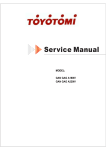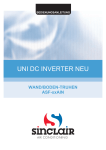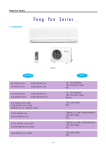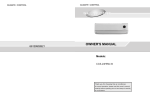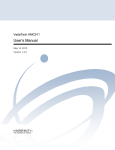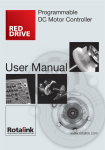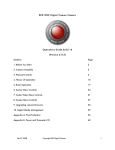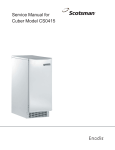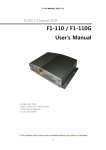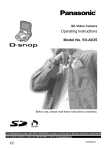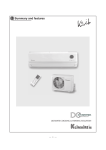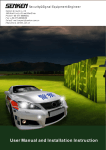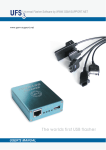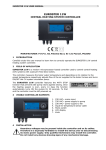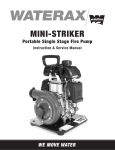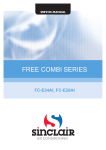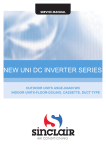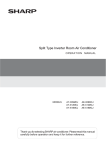Download ash-24ain (pt)
Transcript
SERVICE MANUAL ) NORDIC SERIES ASH-18AIN (PT), ASH-24AIN (PT) 2 Specifications and Technical Parameters ASH-18AIN (PT) Model COOLING Function Rated Voltage HEATING ASH-24AIN (PT) COOLING 220-240V~ Rated Frequency Total Capacity (W) (Low / High / Standard) Total Capacity (Btu/h) (Low / High / Standard) Power Input (W) HEATING 220-240V~ 30 / 100 / 75 30 / 100 / 72 25 / 100 / 82 25 / 100 / 74 2500 / 5800 / 5300 2300 / 6400 / 5850 2000 / 6800 / 6500 1600 / 8200 / 6500 5460 / 28000 / 22200 470 / 3250 / 1800 8500 / 19800 / 18100 620 / 2200 / 1560 550 / 2250 / 1620 6800 / 23200 / 22200 520 / 2450 / 2020 Rated Input (W) 2400 2450 3200 3250 Rated Current (A) 10.48 10.71 14 14.2 3 Air Flow Volum e (m /h) (H/M/L)** Dehum idifying Volum e (l/h) EER / C.O.P (W/W) Energy Clas s Model of Indoor Unit Fan Motor Speed (r/m in) (H/M/L) Output of Fan Motor (w) Input of Heater (w) Fan Motor Capacitor (uF) Fan Motor RLA(A) Fan Type-Piece Diam eter-Length (m m ) Evaporator Pipe Diam eter (m m ) Row-Fin Gap(m m ) Indoor Coil length (l) x height (H) x unit coil width (L) Swing Motor Model Output of Swing Motor (W) Fus e (A) Sound Pres s ure Level dB (A) (H/M/L) Sound Power Level dB (A) (H/M/L)*** Dim ens ion (W/H/D) ( m m ) Dim ens ion of Package (L/W/H) ( m m ) Net Weight /Gros s Weight (kg) 2300 / 6400 / 5850 900 / 800 / 675 850 / 750 / 650 2 2.4 3.40 / 3.61 3.22 / 3.61 A/A A/A ASH-18AIN (PT) ASH-24AIN( PT) 1400/1200/1100 1400/1200/1100 45 45 / / 3 3 0.2 0.2 Cros s flow fan – 1 Cros s flow fan – 1 φ 96 X 797 Alum inum fin-copper tube φ 96 X 797 Alum inum fin-copper tube Φ7 2-1.6 Φ7 2-1.6 787X400X25.4 787X400X25.4 MP28AA MP28AA 2 2 PCB 3.15A Trans form er 0.2A PCB 3.15A Trans form er 0.2A 48/43/40 48/43/40 58/53/50 58/53/50 1020X319X234 1020X319X234 1078X325X390 1078X325X390 13/17 13/17 Model of Outdoor Unit Compressor Manufacturer/trademark Compressor Model Compressor Type L.R.A. (A) Compressor RLA(A) Compressor Power Input(W) Overload Protector Throttling Method Starting Method Working Temp Range (℃) Condenser Pipe Diameter (mm) Rows-Fin Gap(mm) Coil length (l) x height (H) x coil width (L) Fan Motor Speed (rpm) Output of Fan Motor (W) Outdoor Fan Motor RLA(A) unit Fan Motor Capacitor (uF) Air Flow Volume of Outdoor Unit Fan Type-Piece Fan Diameter (mm) Defrosting Method Climate Type Isolation Moisture Protection Permissible Excessive Operating Pressure for the Discharge Side(MPa) Permissible Excessive Operating Pressure for the Suction Side(MPa) Sound Pressure Level dB (A) (H/M/L) Sound Power Level dB (A) (H/M/L) Dimension (W/H/D) ( mm) Dimension of Package (L/W/H)( mm) Net Weight /Gross Weight (kg) Refrigerant Charge (kg) Length (m) Gas additional charge(g/m) Connec Liquid Pipe (mm) Outer tion Diameter Gas Pipe (mm) Pipe Max Height (m) Distance Length (m) ASH-18AIN (PT) SANYO C-6RVN93H0V Double Rotary 41 7 1610 1NT11L-3979 Capillary Transducer starting -15℃≤T≤46℃ Aluminum fin-copper tube 7 2-1.4 ASH-24AIN (PT) SANYO C-6RZ146H1B Double Rotary 32 7.78 1500 1NT11L-3979 Capillary throttling Transducer starting -15℃≤T≤46℃ Aluminum fin-copper tube Φ9.52 2-1.4 838×660×25.4 731X813X44 780/600 60W 0.26 3 2700 Axial fan –1 460 Auto defrost T1 I IP24 780/620 60 0.3 2 / Axial fan –1 460 Auto defrost T1 I IP24 3.8 3.8 1.2 1.2 56 66 848X685X378 994X428X750 52 / 57 R410A / 1.6 5 22 58/55 68/65 950X840X420 1100X450X905 68/73 R410a/2.4 5 50 Φ9.52(3/8”) Φ16(5/8”) 8 30 Φ6(1/4”) Φ12(1/2”) 8 30 The above data is subject to change without prior notice. 3 Component Name Air inlet Indoor unit Ń Ł ł ń Air Outlet Ņ Set Temp Wireless remote control Heat (This indicator is black for singlecooling unit). Cooling Air inlet (1) Front Panel (2) Guide louver (3) Receiving window (4) LED Board (5) Wall Pipe (6) Wrapping (7) Drainage hose () Connection Outdoor unit Tape pipe and connection wire Air Outlet 4 Overall and Installing Dimension Overall and Installing Dimension of Indoor Unit Air inlet grill Left Tube-exit hole Top View Rear View Rear panel Right Tube-exit hole Unit: mm Overall and Installing Dimension of Indoor Unit(18K) Unit: above above above above Bolt Nut Wrench mm Overall and Installing Dimension of Indoor Unit(24K) Unit: mm Nut Bolt Wrench 5 Electrical Diagram ASH-18AIN (PT) ASH-24AIN (PT) 6 Manual of functions of remote controller and operation method Manual of functions of remote controller Applicable to ASH-18AIN (PT)Controller Function of Indoor Unit Temperature parameters Indoor setting temperature (Tpreset) Indoor ambient temperature (Tamb.) System basic function Cooling mode In this mode, the indoor fan will run at preset fan speed. When the compressor stops for outdoor unit malfunction protection, the indoor fan will still run at preset fan speed. Temp. can be set in the range of 16-30 . Dehumidifying mode Indoor fan will run at low speed invariably. Swing will operate according to setting status. Temp. can be set in the range of 16-30 . Fan mode Indoor fan and swing will operate according to setting status. Temp. can be set in the range of 16-30 . Heat mode In heating mode, if compressor is running, indoor fan will delay to run to avoid cold air blowing.When compressor stops, blowing When compressor stops, blowing residual heating will enter. Blowing residual heat: In heating mode, the unit is stopped by remote controller, indoor fan will continue to run for 60s. Fan speed can not be switched during blowing residual heat. Temp. can be set in the range of 16-30 . Auto mode In this mode, the system selects COOL, HEAT and FAN mode automatically according to the change of ambient temperature. Protection function is the same as that in cooling and heating mode. Other control ON/OFF Each time the On/Off button of the remote controller is pressed, the On/Off state will switch once. Modes selection Press the MODE button on the remote controller to select and display the following modes: AUTO, COOL, DRY, FAN, HEAT,AUTO. TEMP. Setting Button Each time button is pressed, the set temperature will be increased or decreased by 1 .Adjusting range is 16~30 . In AUTO mode, this button does not function. 3.4 Manual Button (ON/OFF ) If press AUTO button under off status of the unit, the unit will run under auto mode with swing.If press AUTO button under on status of the unit,the unit will be stopped.If remote controller command is given,the mian unit will run under the command. Timer function Timer on The system will continue to run if TIMER ON is set when the system is under ON status. If TIMER OFF is set when the system is under OFF status, the system will start to run under preset mode upon the time for auto start. Timer off If TIMER OFF is set when the system is under OFF status, the system will maintain its standby status upon the time for auto stop. If the TIMER OFF is set when the system is under ON status, the system will be stopped upon the tome for auto stop. 3.5.3 Set TIMER ON/OFF Simultaneously If TIMER ON and TIMER OFF is set simultaneously when the system is under run status, the system will maintain its current operating status and be stopped upon the coming of preset time If TIMER ON and TIMER OFF is set simultaneously when the system is under stop status, the system will maintain its stop status. It will be started until the time for auto start. At the time for auto start every day, the system will run under preset mode.At the time for auto stop, the system will be stopped. Noise silencing is provided under heating mode. If the unit is restarted in less than 3 minutes after it is stopped,3-minute lag protection is provided for the compressor. 3.5. 4 Change of Timer When the system is under TIMER ON/OFF status, switch on or off the unit by pressing ON/OFF key by remote controller, Timer can be reset. The system will run under the last status setting. 3.6 Sleep Function Setting SLEEP function under COOL or DEHUMIDIFY mode, the preset temperature will automatically rise by 1℃ after 1 hour and rise by another 1℃ after 2 hours. Preset temperature will rise by 2℃ in total within 2 hours. After that, the unit will run at this preset temperature , the indoor fan will run at preset speed. Setting SLEEP function under HEAT mode, the preset temperature will automatically decrease by 1 after 1hour and decrease by another 1 after 2 hours. Preset temperature will decrease by 2 in total within 2 hours. After that, the unit will run at this preset temperature , the indoor fan will run at preset speed. No sleep function under fan mode and auto mode. 3.7 Speed Control of Indoor Fan The indoor fan will select fan speed(HIGH, MED or LOW) automatically according to the change of ambient temp.It can also be set by remote controller. 3.8 Buzzer When the unitis energized, pressed, or receives a signal from remote controller, the buzzer will give out a beep. 3.9 Swing Control After energized, guide louver will first anticlockwise turn to A position, and then close the air outlet. After the unit is turned on, guide louver will return standby to max. air outlet D2 for heating; for cooling, guide louver will first turn to air outlet D1 and then return standby to L1. If the unit is in swing condition, the guide louver will swing between L1 and D1 for cooling and between L and D2 for heating. After the unit is off, guide louver will anticlockwise turn to A position to close air outlet. 3.10 Memory Function What can be memorized includes: mode, swing,preset temperature, preset fan speed.If the system is in timer and sleeping .status,preset timer and sleeping can not be memorized and will be canceled after the power is off,which must be reset, 3.11 Indoor Indicators In normal state,power supply/mode/fan speed/preset temp. indicator will display by current state.Every time of receiving command from remote controller,preset temp. will display blink for 10s.In other conditions,ambient temp. displays. Controller Function of Outdoor Unit 1 Temperature Parameters 1.1 Cooling Mode 1.1.1 Working Conditions and Process of Cooling If the compressor is in off status,and (Tin-amb.-Tpreset) 0.5 , start the unit in cooling mode,in which case,outdoor fan and compressor start running,and microcomputer will auto adjust the frequency of compressor by cooling capacity requirements. In cooling running,if 0 (Tpreset-Tin-amb.) 2 ,the compressor will run at low frequency. In cooling running,if capacity requirements is 0( unit stop for cooling ),and (Tpreset-Tin-amb.) 2 ,the compressor will stop, and outdoor fan will stop running in 60S. In this mode, switch valve is de-energized,and the temp. can be set in the range of 16-30 . 1.1.2 Antifreeze Protection In cooling or dehumidify mode,if it is detected that the system is under antifreeze protection, the compressor will stop or run with frequency decline ,and outdoor fan will bestopped in 60S. When antifreeze protection is releasedthe unit will resume its original operating status. 1.2 Dehumidifying Mode 1.2.1 Working Conditions and Process of Dehumidifying Same with Cooling Mode In this mode, switch valve is de-energized,and the temp. can be set in the range of 16-30 1.2.2 Protection is same with Cooling mode 1.3 Fan Mode Compressor, outdoor fan and 4-way valve shut off. Temp. setting range:16-30 . 1.4 Heating Mode 1.4.1 Working Conditions and Process of Heating If Tamb 3 Tpreset 0.5 , the unit will start heating, in which case, compressor, outdoor fan and 4-way will run. If Tamb 3 Tpreset 2 , the compressor will run at 30Hz. If Tamb 3 Tpreset 2 , the compressor will stop running and outdoor fan will stop running after 1min delay. Stop the unit or switch into other modes in heating mode, the 4-way valve will de-energize after the compressor has stopped for 2min. In this mode, the Temp. setting range should be 16-30 . 1.4.2 Defrosting Process Outdoor microcomputer system will accord to the frost on evaporator, outdoor tube temp sensor to judge whether it enters defrosting process. If satisfied the defrosting process, compressor will stop, 4-way valve reversal; Compressor runs at high frequency running, indoor fan will run by blowing exhaust heat. 2.Current Protection Function in Cooling/Heating/Dehumidifying Mode 2.1 Overload pretection When Ttube is detected too high, the compressor will run in limited or dropped frequency.When Ttube goes on rising over the stated value, the compressor will stop.If Ttube resumes normal, so does the complete unit according to capacity requirements. If 6 successive times of overload protection happens,the compressor won't resume running except pressing ON/OFFbutton. In running process,if the comprssor has runfor 7 min,the times of overload protection will be cleared. 2.2 Delay pretection for compressor Once be stopped, the compressor can not be restarted within 3mins. 2.3 Exhaust Temperature Protection If it is detected by the outdoor controller that the exhaust temperature is too high, the compressor will run in limited or dropped frequency. If the exhaust temperature goes on rising over the stated value, the compressor will stop and it is detected that the exhaust temperature has resumed normal, the compressor will resume running according to capacity requirements. If 6 successive times of overload protection happens,the compressor won't resume running except pressing ON/OFFbutton. In running process,if the comprssor has runfor 7 min,the times of overload protection will be cleared. 2.4 Current Protection Function 2.4.1.Overload protection Once detected the whole unit current exeed the limit value 14. OA, that indoor temp. arrived, the unit will stop to run, the compressor stopped 3mins, will automatically resume to running status, protection times exceeds 6 times ( If compressor running time exceeds 7mins that the protection times will be cleared to 0), the system will be turned off and send the over current protection malfunction signal to indoor unit, cannot automatically resume to run, it must be press ON/OFF to turn off the unit. 2. 4. 2 Current drop frequency, limit frequency control When detected the whole unit current 12. 0A, forbidden frequency rise. When detected the whole unit current 13. 0A, and f max. running frequency, compressor drop frequency. 2.5Communication malfunction When continuously 3mins. without receive from indoor or 10s cannot receive signal from drive board that is communication malfunction, outdoor unit will stop. 2.6 Module protection Module protection, compressor stop, the unit will stop when indoor temp. arrive at setting temp., after compressor has stopped 3mins. later, it will resume to running status; if continuously 6 times module protection, the compressor cannot resume to run. It is need to press ON/OFF can resume. (If compressor running time exceeds 7min that the protection time will be clear to 0). 2.7 Demagnetization current protection The peak value for demagnetization current is 41A, when deteced this value is more than regulated value, whole unit will drop frequency, after drop frequency, if detected the value still more than regulated value, the compressor will stop to run. After drop frequency, if the value is less than the regulated value, it will resume to the target frequency point. And resume to the target frequency point procedure, detect demagnetization current peak value is more than regulated value, then execute the drop frequency order. 2.8 Compressor phase current protection During compressor running, detected the compressor’s phase current and according to the following logic for control: (1) If detected DC generatrix current 13A, compressor drop frequency running (indicator displays DC generatrix overcurrent protection drop frequency), then detected DC generatrix current 12A, and target frequency more than the running frequency, the compressor’s frequency rise up to target frequency running, if target frequency is less than frequency or there is any other frequency happens, the slow rise limit will be canceled. When whole unit running drop frequency arrives the lowest frequency and DC generatrix 13A, when arrive at the temperature point unti will stop and displays the generatrix over current protection malfunction, compressor has stopped 3mins, will automatically resume to running status. (2) If compressor frequency rise and deteced any phase current 12A that the compressor frequency rise up to the target frequency running. 2.9 Module over heat protection function If detected the module surface temp. 110 , the whole unit will accord to IPM module protection process. 3 Outdoor indicators display status D101 (Green) Definition D102 (Red) The meaning of lights blinks for mainbaord Definition D104 (Yelllow) Definition 1Blink Compressor runs 1Blink 1Blink 2Blinks Unit stop for compressor high pressure protection Air exhaust protection drop frequency 2Blinks 2Blinks Over current protection drop frequency 3Blinks 3Blinks Refrigerant over load drop frequency 3Blinks Unit stop for air exhaust protection 4Blinks Unit stop for communication malfucntion (including indoor unit and drive board) 4Blinks 4Blinks Heating anti-high temp. drop frequency 5Blinks Unit stop for module protection 5Blinks 5Blinks Preserved for one to two use 6Blinks Unit stop for over current protection 6Blinks 7Blinks Unit stop for refrigerant overload 7Blinks 8Blinks Unit stop for heating anti-high temp. 9Blinks 10Blinks Unit stop for refrigerant anti-freezing Unit stop for Temp. sensor malfunction 11Blinks Unit stop for compressor overload protection 12Blinks Unit stop for compressor low pressure protection 13Blinks Unit stop for DC generatrix over current protection 14Blinks 15Blinks EEPROM fault DC power supply short circuit 8Blinks Communication malfunction signal sent from indoor 6Blinks 7Blinks 8Blinks Defrosting Anti-freezing protection drop frequency DC generatrix over current protection drop frequency D105 (Red) 1Blink 2Blinks 3Blinks 4Blinks 5Blinks 6Blinks 7Blinks Definition Air exhaust protection limit frequency Overcurrent protection limit frequency Refrigerant overload limit frequency Heating anti-high temperature limit frequency Preserved for one to two use Oil return Anti-freezing drop frequency Definition D106 (Green) Air exhaust protection limit frequency 1Blink 2Blinks 3Blinks Outdoor tube sensor malfunction Outdoor air exhaust sensor malfunction 4Blinks 5Blinks Preserved Malfunction with drive board (cannot receive correct data from drive board 10s) 6Blinks 7Blinks Meaning of lights blinks for drive board LED1 LED1 RedDrive Definition LED2 GreenLED2 Drive Definition Dark Normal, reset unit stop Bright Communication malfunction (no data receiving by10s) 1Blink Compressor normally runs Blink Communication normal 2Blinks Unit stop for abnormal 3Blinks 4Blinks 5Blinks IPM protection IPM Demagnetization protection PFC protection PFC 6Blinks Continuously 5times startup failure 7Blinks Startup failure 8Blinks Lack voltage 9Blinks 10Blinks Over voltage IPM overheat protection D108 (Green) 1Blink Definition Received verified correct indoor data 6 Controller Function Manual Remote Controller Function Manual Applicable to: ASH-24AIN (PT) Controller Function of Indoor Unit 1 Temperature Parameters Indoor preset temperature (Tpreset) Indoor ambient temperature (Tamb.) 2. Basic Functions 2.1 Cooling Mode In this mode, the indoor fan will run at preset fan speed. When the compressor stops for outdoor unit malfunction protection, the indoor fan will still run at preset fan speed. Under this mode, temperature setting range will be 16-30 . 2.2 Dehumidifying Mode Indoor fan will run at low speed invariably. Swing will operate according to setting status. Under this mode, temperature setting range will be 16-30 . 2.3 Fan mode Under this mode, indoor fan motor, swing motor will run at setting status. Under this mode, temperature setting range will be 16-30 . 2.4 Heating Mode In heating mode, if compressor is running, indoor fan will delay to run to avoid cold air blowing. When compressor stops blowing residual heating will enter. Blowing residual heat: In heating mode, the unit is stopped by remote controller, indoor fan will continue to run for 60s. Fan speed can not be switched during blowing residual heat. Under this mode, temperature setting range will be 16-30 . 2.5 Auto Mode In this mode, the system selects COOL, HEAT and FAN mode automatically according to the change of ambient temperature. Protection function is the same as that in cooling and heating mode. 3 Other Control 3 .1 ON/OFF Each time the On/Off button of the remote controller is pressed, the On/Off state will switch once. 3.2 MODE Selection Press the MODE button on the remote controller to select and display the following modes: AUTO, COOL, DRY, FAN, HEAT,AUTO. 3.3 TEMP. Setting Button Each time button is pressed, the set temperature will be increased or decreased by 1 .Adjusting range is 16~30 . In AUTO mode, this button does not function. 3.4 Manual Button (ON/OFF ) If press AUTO button under off status of the unit, the unit will run under auto mode with swing.If press AUTO button under on status of the unit,the unit will be stopped.If remote controller command is given,the mian unit will run under the command. 3.5 TIMER ON/OFF 3.5.1 TIMER ON The system will continue to run if TIMER ON is set when the system is under ON status. If TIMER OFF is set when the system is under OFF status, the system will start to run under preset mode upon the time for auto start. 3.5 .2 TIMER OFF If TIMER OFF is set when the system is under OFF status, the system will maintain its standby status upon the time for auto stop. If the TIMER OFF is set when the system is under ON status, the system will be stopped upon the tome for auto stop. 3.5.3 Set TIMER ON/OFF Simultaneously If TIMER ON and TIMER OFF is set simultaneously when the system is under run status, the system will maintain its current operating status and be stopped upon the coming of preset time If TIMER ON and TIMER OFF is set simultaneously when the system is under stop status, the system will maintain its stop status. It will be started until the time for auto start. At the time for auto start every day, the system will run under preset mode.At the time for auto stop, the system will be stopped. Noise silencing is provided under heating mode. If the unit is restarted in less than 3 minutes after it is stopped,3-minute lag protection is provided for the compressor. 3.5. 4 Change of Timer When the system is under TIMER ON/OFF status, switch on or off the unit by pressing ON/OFF key by remote controller, Timer can be reset. The system will run under the last status setting. 3.6 Sleep Function Setting SLEEP function under COOL or DEHUMIDIFY mode, the preset temperature will automatically rise by 1℃ after 1 hour and rise by another 1℃ after 2 hours. Preset temperature will rise by 2℃ in total within 2 hours. After that, the unit will run at this preset temperature , the indoor fan will run at preset speed. Setting SLEEP function under HEAT mode, the preset temperature will automatically decrease by 1 after 1hour and decrease by another 1 after 2 hours. Preset temperature will decrease by 2 in total within 2 hours. After that, the unit will run at this preset temperature , the indoor fan will run at preset speed. No sleep function under fan mode and auto mode. 3.7 Speed Control of Indoor Fan The indoor fan will select fan speed(HIGH, MED or LOW) automatically according to the change of ambient temp.It can also be set by remote controller. 3.8 Buzzer When the unitis energized, pressed, or receives a signal from remote controller, the buzzer will give out a beep. 3.9 Swing Control After energized, guide louver will first anticlockwise turn to A position and then close the air outlet. After the unit is turned on, guide louver will return standby to max. air outlet D2 for heating for cooling, guide louver will first turn to air outlet D1 and then return standby to L1. If the unit is in swing condition, the guide louver will swing between L1 and D1 for cooling and between L and D2 for heating. After the unit is off, guide louver will anticlockwise turn to A position to close air outlet. 3.10 Memory Function What can be memorized includes: mode, swing,preset temperature, preset fan speed.If the system is in timer and sleeping .status,preset timer and sleeping can not be memorized and will be canceled after the power is off,which must be reset, 3.11 Indoor Indicators In normal state,power supply/mode/fan speed/preset temp. indicator will display by current state.Every time of receiving command from remote controller,preset temp. will display blink for 10s.In other conditions,ambient temp. displays. In normal state,power supply/mode/fan speed/preset temp. indicator will display by current state.Every time of receiving command from remote controller,preset temp. will display blink for 10s.In other conditions,ambient temp. displays. Controller Function of Outdoor Unit 1 Temperature Parameters Outdoor exhaust temperature (Texhaust) Outdoor ambient temperature (Tout-amb.) 2 Basic Functions In each mode,once started,the compressor can not be stopped until it has been running for 6 min.(excluding malfunction protection and stopping the compressor for mode switching);once stopped,the compressor should be started in 3-min. delay (including mode switching,stopping the unit for temp. reached or by remote control);the compressor will start after 5S of the indoor fan. 2.1 Cooling Mode 2.1.1 Working Conditions and Process of Cooling If the compressor is in off status,and (Tin-amb.-Tpreset) 0.5 , start the unit in cooling mode,in which case,outdoor fan and compressor start running,and microcomputer will auto adjust the frequency of compressor by cooling capacity requirements. In cooling running,if 0 (Tpreset-Tin-amb.) 2 ,the compressor will run at low frequency. In cooling running,if capacity requirements is 0( unit stop for cooling ),and (Tpreset-Tin-amb.) and outdoor fan will stop running in 60S. 2 ,the compressor will stop, In this mode, switch valve is de-energized,and the temp. can be set in the range of 16-30 . 2.1.2 Antifreeze Protection In cooling or dehumidify mode,if it is detected that the system is under antifreeze protection, the compressor will stop or run with frequency decline ,and outdoor fan will bestopped in 60S. When antifreeze protection is releasedthe unit will resume its original operating status. 2.1.3 Control Logic of Outdoor Fan If Tout-amb. 26 ,outdoor fan will run at high speed. If Tout-amb. 24 ,outdoor fan will run at low speed. In running,if 24 Tout-amb. 26 ,the outdoor fan will remain original. After turning on the unit ,the outdoor fan will be forced to run for 3 min, and then run at logical speed. 3.2.2 Dehumidifying Mode Working conditions and Process of dehumidifying:the same as that in cooling mode. State of 4-way valve: shut-off Temp. setting range:16-30 . Protection function: the same as that in cooling mode. 3.2.3 Fan Mode Compressor, outdoor fan and 4-way valve shut off. Temp. setting range:16-30 . 3.2.4 Heating Mode 3.2.4.1 Working Conditions and Process of Heating , the unit will start heating,in which case, preset amb. If the compressor is in stopped state, compressor, outdoor fan and 4-way valve will run and the microcomputer will adjust frequency of comprssor according to heating requirements. In heating process,if preset amb. preset ,the compressor will run at low frequency. In heating process,if amb. ,the compressor will stop running and outdoor fan will stop preset running after 60-S delay. Note:Stop the unit or switch into other mode in heating mode,the 4-way valve will de-energize after the compressor has stopped for 2 min. In this mode, the reversal valve is energized and temp.setting range is 16-30 . 3.2.4.2 Logic Control of Outdoor Fan If out-amb. the outdoor fan will run at high speed; If out-amb. the outdoor fan will run at low speed; In running process, if the speed will remain original. out-amb. During running,the outdoor fan will be forced to run at high speed for 3min, and then turn to logical speed. 17 2.4.3 Defrosting Process If it is detected the defoeting is required,and if the compressor running frequency is a little higher,the frequency will first reduced to some level and then the compressor and indoor fan stop,50s later,outdoor fan stops meanwhile,4-way valve stops after 45-second delay.The compressor will restart with 90Hz of running frequency in 55s to defrost.Upon defrsoting is completed,compressor running frequency will decrease to 60Hz, and 4-way valve and outdoor fan will start,10s later, compressor will run with increased frequency required by capacity.Indoor fan will run in 2 min at most. If compressor is stopped for malfunction in heating mode,the indoor fan will run by blowing exhaust heat. 3 Current Protection Function in Cooling/Heating/Dehumidifying/Auto Mode 3.1 Overload pretection When Ttube is detected too high, the compressor will run in limited or dropped frequency.When Ttube goes on rising over the stated value, the compressor will stop.If Ttube resumes normal, so does the complete unit according to capacity requirements. If 6 successive times of overload protection happens,the compressor won't resume running except pressing ON/OFFbutton. In running process,if the comprssor has runfor 7 min,the times of overload protection will be cleared. 3.2 Delay pretection for compressor Once be stopped, the compressor can not be restarted within 3mins. 3.3 Exhaust Temperature Pretection If it is detected by the outdoor controller that the exhaust temperature is too high, the compressor will run in limited or dropped frequency. If the exhaust temperature goes on rising over the stated value, the compressor will stop and it is detected that the exhaust temperature has resumed normal, the compressor will resume running according to capacity requirements. If 6 successive times of overload protection happens,the compressor won't resume running except pressing ON/OFFbutton. In running process,if the comprssor has runfor 7 min,the times of overload protection will be cleared. 3.4 Current Protection Function 1.Overload protection If total current is detected over the stated value, the unit will be stopped as the indoor room temperature meet the preset value,after the compressor has stopped for 3 minutes, it will resume its original operating status automatically. If 6 successive times of overload protection happens,the compressor won't resume running except pressing ON/OFFbutton. In running process,if the comprssor has runfor 7 min,the times of overload protection will be cleared. 2.Current dropped frequency or limited frequency control: The controller will drop the compressor frequency or prohibit the compressor frequency rising according to the change of total current. 3.5 Communication Malfunction There is communication malfunction if it can not receiving correct signal for 3 minutes continuously, in which case, the outdoor unit will stop. 3.6 Module Protection When module is in protection, the compressor will be stopped as the indoor room temperature meet the preset value, after the compressor has stopped for 3 minutes, it will resume its original operating status automatically. If 6 successive times of overload protection happens,the compressor won't resume running except pressing ON/OFFbutton. In running process,if the comprssor has runfor 7 min,the times of overload protection will be cleared. 3.7 Overheat Protection of Module If it is detected the IPM temperature is too high, the compressor will run in limited or dropped frequency.If the IPM temperature goes on rising over the stated value, the compressor will stop .When the IPM temperature resumes normal, and the compressor has stopped for 3 min., the complete unit will resume running. If 3 successive times of IPM protection in an hourhappens,the compressor won't resume running except pressing ON/OFFbutton. 3.8 OverloadProtection for compressor If compressor oveload is detected,the indoor unit will stop as the indoor room temperature meet the preset value.If the compressor has stopped for 3 min. ,it should be reset to start. 3.9 9 PFC Protection If start the unit in cooling,heating and dehumidifying mode,the compressor will operate in the frequency of 30Hz,and then PFC occurs after 30s. At any time of stopping compressor,PFC will stop with the compressor at the same time. Once PFC starts,protection signal will be detected soon.During PFC protection,PFC stops with the compressor at the same time. PFC will resume operation automatically after 3min when malfunction happens to it. 18 6.3.3.10 Malfunction Detection of Temp. Sensor and IPM Overheat Detection Sensor (1) In standby condition,malfunction of outdoor tube temp,ambient temp and IPM overheat detection sensor can not be detected. (2)Malfunction of exhaust temp. sensor and IPM overheat detection sensor can be detected after the compressor starts and has run for 3 min. (3) Within 10 min when the compressor starts or after defrosting ,heating and oil return are completed,malfunction of outdoor tube temp. sensor can not be detected. (4) Malfunction of other outdoor temp. senors will be detected soon after the unit is started .The detection will last 30s. (5) Once malfunction of IPM overheat detection sensor or other outdoor temp. sensors is detected,theunit will be stopped soon. 6.3.3.11 Outdoor Indicator Meaning(refer to Troubleshooting section) Definition 1blink Compressor running 2 blinks Stop for exhaust protection 3 blinks Stop for NEC drive module protection 4blinks Stop for overcurrent protection 5blinks Stop for overload 6blinks Stop for refrigerating antifreeze 7blinks Stop for sensor fault 8blinks 9blinks 10blinks 11blinks 12blinks 1blink 2blinks 3blinks 4blinks 5blinks 6blinks 7blinks 8blinks Stop for communication fault (including indoor unit and NEC drive module) Stop for compressor high voltage protection (Preserved) Stop for compressor low voltage protection (Preserved) Cassette unit stop for water flow protection (Preserved) Stop for IPM overheat protection Overcurrent protection drop frequency Refrigerant overcurrent drop frequency Heating overcurrent drop frequency Anti-freezing drop frequency Stop for reduction of frequency to lowest Stop for PFC protection Stop for compressor overload 3blinks 4blinks 5blinks 6blinks 7blinks 8blinks DC input voltage too low DC voltage too high AC current protection IPM abnormal In-built PFC protection Startup failure Phase failure or modulation failure Firstly PFC protection, then module protection Definition 1blink 1blink 2 blinks 3 blinks Fault of communication with indoor unit 2 blinks Defrosting 3 blinks Oil return 4blinks Fault of communication with NCE module 4blinks Nominal refrigerating/heating Fault of communication with computer 5blinks Max. refrigerating/ heating Stop for refrigerating overload Stop for heating overload Quick refrigerating/heating 5blinks 6blinks 7blinks Fault of outdoor ambient sensor 6blinks Medium refrigerating/ heating Fault of outdoor tube sensor 7blinks Min.refrigerating/ heating 8blinks Fault of outdoor exhaust temperature sensor 8blinks 9blinks 10blinks 11blinks 12blinks Communication malfunction sent from indoor unit 9blinks Stop Low pressure unrestorable The parameters sent to NEC drive has some problem, unit stop Fault of IPM temperature sensor Definition Air exhaust protection drop frequency Definition (NEC drive information) 1blink 2blinks Definition Definition 1blink 2blinks 3blinks 4blinks 5blinks 6blinks 7blinks 8blinks 9blinks Air exhaust protection limit frequency Overcurrent protection limit frequency Definition Bright Dark Refrigerant overload limit frequency Heating overload limit frequency Current 9.4A Frequency stays 2mins. Current 12A Frequency stays 2mins. limit frequency or drop frequency Compressor current limit frequency or drop frequncy IPM module overheat limit frequency or drop frequency Definition When computer monitoring port is not short circuited Bright Reciving or sending indoor unit data When computer monitoring port is short circuited Bright Indoor unit data received or sent Dark Reciving or sending indoor unit data Dark Communication between mainboard and drive board is abnormal Receiving or sending computer data Computer data received or sent 7 Disassembly and Assembly Procedures Disassembly Process of Indoor Unit Operating Procedures/Photos Disassemble the Front panel Open the front panel. Firstly to screw off the screws that fixed at the guard plate on the receiving window both sides, disassemble the guard plate, then to remove the wiring terminal, then along the groove that fix the front panel to take out the front panel. Front panel Wire terminal Disassembling the filter and wire-pressed clamp Disassemble the filter, screw off the screw that fix the wire-pressed clamp can disassemble it. Filter Screw Electric box top cover Disassemble air guide louver Bend the air guide louver by hands, and then loose the slipknot on the guide louver to disassemble the guide louver. Air guide louver Operation procedures/pictures Disassemble Front Case Open the three screw covers and unscrew five screws on front case. Pull open the clasp at the front and rear sides, can remove the front panel. Screw cover Screws Disassemble the electric box cover Loosen the 3 slipknots manually, and then pull upwards the electric box cover. Slipknot Dissasemble water tray sub-assy Unscrew the screws fixing the water tray and then loosen the slipknot in the other end. Pull out the terminal of stepping motor, and then pull upwards the water tray to take it out. Slipknot Water tray Terminal Disassemble Electric box Tube sensor unplug the plugging connector of the Plugging connector indoor motor at the electric box, use screwdriver to unscrew the screw fixing Clasp the electric box and remove the electric box. Disassemble Evaporator Use a screwdriver to loosen the screw (1pc) of left side, (2pcs) of right side. Take out the evaporator with your hands, so that the side plate clamp of evaporator falls out from the groove. Remove the evaporator with care. Take care to protect the connecting pipe. Screw Screw Disassemble Motor Use a screwdriver to loosen the 3 screws fixing the motor clamp. Remove the motor clamp. Unscrew the tighten nut which fix cross flow fan, then can take out the motor from the cross flow fan. Screws Motor right clamp Disassemble cross flow fan Take out motor, then remove the cross flow fan from the left bearing holder. Refer to Fig.7-27 Bolts Motor Cross flow fan Disassembly Procedures for Outdoor Unit Operating Procedures / Photos of outdoor unit Disassemble Top Cover Screw off the screws which fix the top cover, then lift it up, can take off the top cover. Top cover Screws Disassemble the handle Screw off one screw which fix the handle, then adown to push the handle, then can take off the handle. Handle Screw Disassemble the rear side plate sub-assy Screw off the screws which fixed the rear grill and rear side plate, disassemble the rear grill, then can take off the rear side plate sub-assy. Rear side plate Rear grill Screws Operating Procedures / Photos of outdoor unit Disassemble the front case Screw off the screw which fix the front case, then pull it upwards, can take off the front case. Front case Screws Disassemble cabinet Screw off the screws which fix the cabinet, then can take off the cabinet. Cabinet Disassemble the electric box sub-assy Screw off 2pcs screw which fix the electric box cover, then can take off the electric box Screws cover. Use the screw driver to screw off 2pcs on the electric box, pull out the wire terminal of the electric box, then lift it up can take off Electric box cover the electric box. Screws Electric box Operating Procedures / Photos Disassemble Valves Screws Unscrew the two screws fixing the gas valve, unsolder the soldering point between the gas valve and the return-air duct and remove the gas valve (note: when unsoldering the soldering point, use wet cloth to completely wrap the gas valve to prevent valve body from being harmed by high temperature). Unscrew the two screws fixing the liquid valve, unsolder the soldering point connecting the liquid valve and the fork type pipe, and remove the liquid valve. Liquid Valve Gas Valve Disassemble Axial Flow Fan Use a spanner to loosen the holding nut to remove the nut, spring washer and flat washer and thenremove the axial flow fan with force. Axial Flow Fan Nut Electrothermal belt Disassemble Outdoor Motor Screw off the four tapping screws fixing the motor, pull out the motor lead-out cable plug and remove the motor. Screw off the two tapping screws fixing the motor support, and pull the motor support upwards to remove it. Screw Motor Screw Operating Procedures / Photos Disassemble 4-Way Valve (Only for cooling and heating unit) Four-way valve Screw off the holding nut of the 4-way valve coil and remove the coil. Use wet cotton cloth to wrap the 4-way valve, unsold the four soldering points connecting the 4-way valve, and remove the 4-way valve. Be quick during the unsoldering process, pay attention to keep the wrapping cloth wet and do not allow the soldering flame to burn the compressor lead-out cable. (caution: only after discharging all freon). Disassemble Capillary Sub-assembly Unsolder the soldering points connecting the capillary sub-assy and the other pipelines, and remove the capillary sub-assy. Capillary Sub-assy 12.Disassemble Compressor Firstly unsolder the pipes connecting the compressor, and then unscrew the three foot nuts at the compressor to remove the compressor. Soldered dots Nut with washer Disassembly Procedure of Outdoor Unit Operating Procedures / Photos Disassemble Front Side Plate Unscrew the screws fixing the front side plate to remove it. As show in Fig.7-13: Screws Front Side Plate Fig. Disassemble Top Cover Unscrew the screws fixing the top cover, and then lift the top cover to remove it. As show in Fig.7-14. Screws Fig. Disassemble Rear Grill Unscrew the screws fixing rear grill and rear side plate.After removing rear grill, disassemble rear Screws side panel sub-assy. As show in Fig.7-15 Fig. Operating Procedures / Photos Disassemble Cabinet Unscrew the screws fixing the cabinet to remove it. Screw Disassemble the electric box Screw off 4pcs screw which fix the electric Screw box, then can take off the electric box cover. Screw off 5pcs screw from electric box, pull out the wire terminal of electric box, then lift Electric Box it up can take off it. Screw Disassemble the rear side plate screw off 8pcs screw which fixed the rear side plate, then can disassemble the rear side plate. Screw Operating Procedures / Photos Disassemble Axial Flow Fan Unscrew the nut fixing the fan with a spanner to take out the fan . Axial Flow Fan Nut Fig. Disassemble Outdoor Motor Unscrew the screws fixing the motor support ,and then lift it upwards to remove it. Unscrew the screws Motor Fixing Screw fixing the motor and pull out the connection line between it and electric box to remove it. Motor Motor Support Motor Support Motor Wire Fixing screw Fig. Disassemble Four-way Valve Only for cooling and heating unit Unscrew the fastening nut of the four-way valve coil and remove the coil. Wrap the four-way valve with wet cotton and unsolder the 4 weld spots connecting the four-way valve to take it out. Welding process should be as quick as possible and keep wrapping cotton wet all the time. Be sure not to burn out the lead-out wire of compressor. Four-way Valve Fig. Operating Procedures / Photos Disassemble Capillary Unsolder the four welding points connecting the two capillary sub-asslies with the liquid valve and the condenser, and remove the capillary sub-assy. As show in Fig.7-22) Disassemble Gas Valve and Liquid Valve Unscrew the four bolts fixing the two valves, unsolder the welding point connecting the gas valve with the return-air pipe, and remove the gas valve (caution: when unsoldering the soldering point, wrap the gas valve completely with wet cloth, so as to prevent the valve body from harmed by high temperature). Unscrew the four bolts fixging the liquid valve, and remove the liquid valve. (refer to Figure 7-23) Fig. Capillary Liquid Valve Gas Valve Bolt Bolt Fig. Disassemble Compressor Unscrew the six nuts with washers at the feet of the Compressor two compressors (caution: only after discharging all freon). Unsolder the suction and the discharge pipes of the compressor, carefully remove the pipes and take out the compressor. (refer to Figure 7-24) Fig. 8 Exploded View and Components and Parts List Exploded View of Indoor Unit Components and Parts List of Indoor Unit No Description 1 2 3 4 5 6 7 8 9 10 11 12 13 14 15 16 17 18 19 20 21 22 23 24 25 26 27 28 29 30 31 32 33 34 35 36 37 38 Wall-Mounting Frame Rear Case Helicoid tongue Cross Flow Fan Evaporator Assy Front Case Front Panel Water Tray Guide Louver(up) Guide Louver(down) Room Sensor 15k Electric Box Cover 1 Electric Box Cover Main PCB Wire Clamp Terminal Board T4B3A Lower Shield of Electric Box Transformer 57X25C Tube Sensor 20k Sensor Insert Upper Shield of Electric Box Receiver Board 5H53EA Electric Box Filter Assy Evaporator Support Drainage Pipe Pipe Clamp Screw Cover Fan Bearing Motor FN20X Swing Link 1 Swing Link 2 Swing Louver Swing Louver Power Cord Motor Clamp Remote Controller YB1B4 Stepping Motor MP28AA The above data is subject to change without prior notice. Part Code ASH-18AIN (PT) 01252004 22202329 26252009 10352022 010022283 200026529 20002844 20182057 10512085 10512086 390000451 20112019 201120201 30032050 71010103 42011233 01592037 43110237 390000595 42020063 01592038 30545552 20112018 11122048 24212067 05230014 24242001 24252015 76512210 150120671 10582057 10582058 10512429 10512430 none 26112095 30511005 15212001 Qty 1 1 1 1 1 1 1 1 1 1 1 1 1 1 1 1 1 1 1 1 1 1 1 2 1 1 1 3 1 1 1 1 11 1 0 1 1 1 Exploded View of Indoor Unit Components and Parts List of Indoor Unit No Description 1 2 3 4 5 6 7 8 9 10 11 12 13 14 15 16 17 18 19 20 21 22 23 24 25 26 27 28 29 30 31 32 33 34 35 36 37 38 Wall-Mounting Frame Rear Case Helicoid tongue Cross Flow Fan Evaporator Assy Front Case Front Panel Water Tray Guide Louver(up) Guide Louver(down) Room Sensor 15k Electric Box Cover 1 Electric Box Cover Main PCB Wire Clamp Terminal Board T4B3A Lower Shield of Electric Box Transformer 57X25C Tube Sensor 20k Sensor Insert Upper Shield of Electric Box Receiver Board 5H53EA Electric Box Filter Assy Evaporator Support Drainage Pipe Pipe Clamp Screw Cover Fan Bearing Motor FN20X Swing Link 1 Swing Link 2 Swing Louver Swing Louver Power Cord Motor Clamp Remote Controller YB1B4 Stepping Motor MP28AA Part Code ASH-24AIN (PT) 01252004 22202329 26252009 10352022 010022362 200026529 20002844 20182057 10512085 10512086 390000451 20112019 201120201 30032050 71010103 42011233 01592037 43110237 390000595 42020063 01592038 30545552 20112018 11122048 24212067 5230014 24242001 24252015 76512210 150120671 10582057 10582058 10512429 10512430 none 26112095 30511005 15212001 The above data is subject to change without prior notice. Qty 1 1 1 1 1 1 1 1 1 1 1 1 1 1 1 1 1 1 1 1 1 1 1 2 1 1 1 3 1 1 1 1 11 1 0 1 1 1 Exploded View of Outdoor Unit Components and Parts List of Outdoor Unit No D e s c rip tio n P a rt C o d e ASH-18AIN (PT) Q ty 1 F ro n t G rill 01473008 1 2 F ro n t P la te 01303162P 1 3 L e ft H a n d le 26235401 1 4 Axia l F lo w F a n 10335253 1 5 M e ta l B a s e 01203633P 1 6 765100041 1 7 E le c tric H e a te r B a n d M o to r F W 6 0 T 15013703 1 8 M o to r S u p p o rt 01705003 1 9 C o n d e n s e r S u p p o rt 01793004 1 10 P ip e P ro te c tio n D e vic e s 76512406 2 11 C o n d e n s e r As s y 01133461 1 3900028001 1 12 Sens or 13 T o p C o ve r 01255001 1 14 R e a r G rill 01473006 1 15 Is o la tio n S h e e t 01233054 1 16 R e a c to r(P F C ) 43120011 1 17 L iq u id -g a s S e p a ra to r 07225001 1 18 4 - W a y Va lve 430004032 1 19 4 - W a y Va lve C o il 430004002 1 20 03103547 1 21 C a p illa ry S u b -As s y R e a r S id e P la te 01305013 1 22 H a n d le As s y 26235255 1 23 P o w e r M o d u le 32210055 1 24 P F C M o d u le 30111018 1 25 M o d u le S u p p o rt B a s e 24213029 4 26 S c re w M 4 X2 0 70110274 4 27 M o d u le S u p p o rt C a p 24213010 4 28 M a in P C B W B 8 2 3 5 E 30038216 1 29 S c re w M 4 X2 0 70110274 4 30 M o d u le S u p p o rt B a s e 24213029 4 31 M o d u le S u p p o rt C a p 24213030 4 32 R a d ia to r 49013008 1 33 E le c tric B o x 4 20112036 1 34 W irin g T e rm in a l 42010255 1 35 W ire C la m p 71010102 1 36 Is o la tio n W a s h e r 70410523 1 37 W ire C la m p 71010003 1 38 E le c tric B o x As s y 01403532 1 39 F u s e S u p p o rt 24213032 1 40 F u s e As s y 46010056 1 41 F ilte r 3 0 S S 4 -1 B C 2 -R -Q 43130012 1 42 C a p a c ito r C B B 6 1 3 u F /4 5 0 V 33010027 1 43 E le c tric B o x C o ve r 01413102 1 44 Va lve 1 /2 " 071302392 1 45 Va lve 1 /4 " 07130239 1 46 Va lve S u p p o rt 01715006 1 47 R u b b e r fo o t o f c o m p re s s o r N ON E 3 48 O H T h e rm is to r N ON E 1 49 50 C o m p re s s o r C -6 R VN 9 3 H O V E le c tric H e a te r B a n d (C o m p re s s o r ) The above data is subject to change without prior notice. 00103041 7651300401 1 1 Exploded View of Outdoor Unit Components and Parts List of Outdoor Unit No D e s c rip tio n P a rt C o d e ASH-24AIN (PT) Q ty 1 F ro n t G rill 01473001 1 2 H o u s in g 01433011 1 3 S m a ll H a n d le 26235401 1 4 C la p b o a rd As s y 01233039 1 5 Axia l F lo w F a n 10335253 1 6 F a n M o to r F W 6 0 T 15013703 1 7 M o to r S u p p o rt S u b -As s y 01703087 1 8 C o n d e n s e r As s y 01103910 1 1 10 T e m p S e n s o r S u p p o rt T o p C o ve r 24213005 01255262 1 11 R e a r G rill 01475252 1 12 R e a c to r 43120011 1 13 44020334 14 R e la y VC 1 5 -3 A1 B E le c tric B o x As s y 01403592 1 1 15 M o d u le S u p p o rt 24213008 1 16 P C B JG P 0 1 1 30111018 1 17 E le c tric B o x C o ve r S u b -As s y 01403629 1 18 M a in P C B 2 W 9 W 2 30039165 1 19 P C B S u p p o rt ( u p ) 24213029 8 20 P C B S u p p o rt ( d o w n ) 24213010 8 21 P C B S u p p o rt 24213009 1 22 M a in P C B 1 W 9 W 2 C 30039198 1 23 F ilte rin g B o a rd W 9 W 2 30039163 1 24 T e m p e ra tu re S e n s o r 3900028001 1 1 9 25 S e n s o r In s e rt 42020063 26 S e n s o r In s e rt 42020066 1 27 C a p a c ito r 33010027 1 28 C a b le -C ro s s L o o p 76510021 1 29 T e rm in a l B o a rd 42011043 1 30 T e rm in a l B o a rd 42011242 1 31 F ilte r 43130008 1 32 W ire C la m p 71010102 1 33 Is o la tio n W a s h e r 70410523 1 34 W ire C la m p 71010003 1 35 C a b le -C ro s s L o o p 76514004 5 36 R a d ia to r 49013011 1 37 C a p illa ry S u b -As s y C u t-o ff Va lve 03103397 1 38 07130209 1 39 H a n d le 26235253 2 40 4 -w a y Va lve 43000411 1 41 4 -w a y Va lve F ittin g s 4300040022 1 1 43 G a s Va lve S u b -As s y R e a r S id e P la te 07103030 01305260 1 44 C a b le -C ro s s L o o p 76515203 1 45 C o m p re s s o r 00103051 1 46 U n d e rp a n As s y F ro n t S id e P la te 01203560 1 01305247 1 32003001 1 06813401 1 765100041 1 42 47 48 49 50 E le c tric H e a te r B a n d (C o m p re s s o r ) C h o k e P lu g E le c tric H e a te r B a n d (M e ta l B a s e ) The above data is subject to change without prior notice. 9 Troubleshooting Common section Analysis in this section is used for Linge Wind D.C. Inverter Series. Before analysis, you can diagnose according to the indicator display on outdoor unit. When the breaker is set ON, it will trip at once Measure the insulating resistance for grounding to confirm whether there is electrical leakage or short circuit in the unit When the unit is turned on, the breaker will trip in a few minutes Insulation malfunction of line or componen in the air conditioner. Insulation breakdow occurs after radiation, which causes shor circuit or electricity leakage. Measure insulating resistance or use one-by-on elimination method; Malfunction of fuse. Replace it. Breaker tripped or fuse burnt out Air conditi oner cannot start up Air conditioner does not response after powered on. (The buzzer does not sound after the plug is connected and the unit does not response after the remote controller is used to turn it on) Remote controller does not receive signal (When powered on, the buzzer will send out a sound, unless it is broken) No power supply Check power supply circuit The power plug is not or poorly connected Check and plug well plug, make loosen contact firm Controller fuse is burnt out Change control fuse Loose or poor contact of transformer connection, or transformer malfunction Secure the wire connection: measure the output voltage of the transformer and replace it if the value is wrong The controller is broken Replace the controller Batteries of remote controller are low Change battery Malfunction of remote controller Loose or poor connection of receiving head Receiving head is broken 39 First press the "AUTO" button of the manual switch. If there is no response, check according to the above method; if it is normal after the button is pressed, check if the installation location and wire connection of the receiving head are correct. If correct, replace the receiving head, or the remote controller. Improper setting of temperature Adjust the set temperature Whether cooling (heating) load is proper Check the estimated load of cooling (heating) Poor cooling (heating) effect Malfunction of refrigerant flow Leakage or shortage of refrigerant Vacuumize after leakage detection and leakage repair. Charge refrigerant according to specification. Leakage occurs between high and low pressure inside compressor Replace the compressor Malfunction of four-way valve Replace the four-way valve Partial blockage of capillary Replace the capillary Blockage of cooling system Use the method of observing condensation on the evaporator and pressure value of high pressure manometer to see whether the system is blocked and carry out corresponding handling on the system Poor thermal insulation of connecting pipe of indoor and outdoor unit Air circulation is insufficient Ensure that both thick pipe and thin pipe are insulated well. The exposed part of the connector and copper pipe must be insulated as well. Heat exchanger of outdoor unit is blocked Clean the dust accumulated on the surface of the heat exchanger Air filters are blocked Clean the filter Fan speed is set too slow Set the fan speed to high or medium speed Fan speed turns low Improper installation location for outdoor unit Damage of capacitor damaged Replace capacitor Damage of motor Replace the motor the Outdoor unit should be installed in a place with well ventilation Outdoor temperature is too high Flashing or awning can be installed appropriately. If the max. cooling capacity cannot be satisfied, replacement of the air conditioner is recommended. Indoor sealability is inadequate; too many people go in and out frequently; there is heating unit in the room. Maintain a certain degree of indoor sealability. Try not to use appliance with high amount of heat. 40 When unit is cooling or heating, both compressor and outdoor fan don’t run When unit is cooling or heating, the compressor runs but outdoor fan doesn’t run When cooling or heating, outdoor fan runs, but compressor doesn’t run. When cooling or heating, outdoor fan runs, but compressor doesn’t run. Fan doesn’t run when FAN mode is set Abnormal power supply of outdoor unit Check the circuit according to circuit diagram Damage of outdoor main control board AP2 Replace the main control board AP2 Breakage of outdoor power module AP4 Replace the power module AP4 Improper setting of temperature Adjust the set temperature Breakage of outdoor fan motor Replace the fan motor Wrong wire connection Wire according to the circuit diagram Breakage of outdoor main control board AP2 Replace the main control board AP2 Breakage of outdoor fan capacitor C1 Replace the fan capacitor C1 Malfunction of compressor Replace the compressor Poor contact of connection between the main control board AP2 and module AP3 Re-fasten the connection Abnormal input P, N of power module AP4 Check if input is 320V. If not, replace the rectifier Abnormal output of power module AP4 Replace the power module AP4 Compressor temperature is too high Cool the compressor for 30 min before running Wrong wiring Wire according to the circuit diagram Damage of outdoor main control board AP2 Replace the outdoor main control board AP2 Burn-out or broken wire of indoor fan motor Repair or change the fan motor Wrong wiring Wire according to the circuit diagram Circuit break or damage of fan motor capacitor 41 Replace the indoor main control board PCB Drainage pipe blocked or broken Change drainage pipe Water leakage Wrap of refrigerant pipe joint is not close enough. Re-wrap and make it tight. Fan of indoor unit contacts other parts. Adjust fan location. Foreign object in indoor unit Take out the foreign object. Compressor shakes too much. Adjust support washer of compressor, and tighten loosen screws. Touch of pipeline of outdoor unit Separate the touching pipeline. Touch of inner plates 1. Tighten connect screw. Abnormal sound and shake 2. Stick absorbing clay between plates. Louver of outdoor unit touched outer case. Adjust location of louver. Abnormal sound inside compressor Change compressor Abnormal solenoid sound from 4-way valve when heating Circuit-short inside solenoid of the valve and change the solenoid valve. Note: 1. When maintaining, before detecting the voltage between the modular PN is less than 50V, please never touch any of the terminals, in order to avoid electric shock. 2. When replacing the batteries, commutating bridge, both of them should be coated with the coolant. 42 Analysis or processing of some of the malfunction display: 1. Compressor discharge protection Possible reasons: shortage of refrigerant; blockage of air filter; poor ventilation or air flow short pass for condenser; the system has noncondensing gas (such as air, water etc.); blockage of capillary assy (including filter); leakage inside four-way valve causes incorrect operation; malfunction of compressor; malfunction of protection relay; malfunction of discharge sensor; outdoor temperature too high. Processing method: refer to the malfunction analysis in the above section. 2. Low voltage overcurrent protection Possible reason: Sudden drop of supply voltage. 3. Communication malfunction Processing method: Check if communication signal cable is connected reliably 4 Sensor open or short circuit Processing method: Check whether sensor is normal, connected with the corresponding position on the controller and if damage of lead wire is found. 5. Compressor overload protection Possible reasons: insufficient or too much refrigerant; blockage of capillary and increase of suction temp.; improper running of compressor, burning in or stuck of bearing, damage of discharge valve; malfunction of protector. Processing method: adjust refrigerant amount; replace the capillary; replace the compressor; use universal meter to check if the contactor of compressor is fine when it is not overheated, if not replace the protector. 6. System malfunction i.e. overload protection. When tube temperature (Check the temperature of outdoor heat exchanger when cooling and check the temperature of indoor heat exchanger when heating) is too high, protection will be activated. Possible reasons: Outdoor temperature is too high when cooling; insufficient outdoor air circulation; refrigerant flow malfunction. please refer to the malfunction analysis in the previous section for handling method . 7. IPM module protection Processing method:Once the module malfunction happens,if it persists for a long time and can not be self- canceled, cut off the power and turn off the unit,and then re-energize the unit again after about 10 min.After repeating the procedure for sever times, if the malfunction still exists,replace the module.(refer to the next page) 8. PTC protection Possible reasons:ambient temp. is too high. or PFC module is too heat;the power orcurrent of complete unit is too high, or PFC voltage is too low;connecting wire of PFC control plate is in poor contact. Processing method:Once protection happens,first check connecting wire of PFC control plate ,and if the unit is still abnormal with continuous protection,replace PFC controller. 43 Module protection Handling method: Check if the voltage between power module P and N is too low and if the current is too high. In normal condition, voltage between P and N should be about 320V. Abnormal Check power supply circuit of outdoor unit (if PTC resistance rectifying bridge, reactor, capacitance etc. is ok). Normal Check if radiating paste is spread evenly or radiating sticker is stuck well; if screws of power module is tightened Temperature of power module is too high, which causes overheating protection Reinstall power module and re-spread radiating paste or stick radiating sticker on the radiator of power module. Protection is still displayed Confirm the setting status of outdoor unit (cooling) Poor radiation, heat exchanger is dirty Remove obstructions and clean Normal Confirm if outdoor fan motor is running; unplug the three connecting wires between U, V, W of compressor Outdoor fan runs and power module. Turn on the unit to see if outdoor fan runs normally (about 1 minute) Confirm if there is voltage output and balance of voltage between any two phases of U, V and W. Outdoor fan stops No Yes Measure the voltage of outdoor fan connector Whether module type is correct Abnormal No voltage Replace the mainboard of outdoor unit Replace the power module Normal Normal voltage Replace the fan motor Replace the module with correct type Measure the three-phase resistance of compressor Normal Whether cylinder of compressor is stuck If the unit runs normally after connected with the new compressor for trial run, the cylinder of original compressor is stuck 44 Abnormal Replace the compressor












































